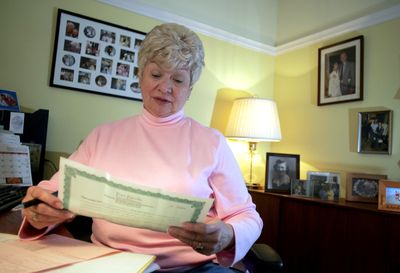Eternal rest for sale
Americans selling burial plots, scaling back on funerals

After months of unemployment and weeks of soul searching, Helen Walker has decided she won’t spend eternity alongside her parents at Fort Lincoln Cemetery in Brentwood, Md.
Instead, the 61-year-old Indian Trail, N.C., resident, who’s worried about making ends meet from one day to the next, is selling off her burial plot and planning to be cremated when she dies.
“I know in my heart my mom’s saying, ‘Take care of yourself. You need to pay your monthly bills. Take care of yourself and if this will help, do it,’ ” said Walker, who lost her job as a cashier in June.
Mounting financial pressures are prompting Americans to sell their cemetery plots for cash, arrange less-formal funerals and consider cremation as a more affordable alternative to burials. Breaking away from traditional, sometimes expensive funeral protocol is just one of the ways families are shaving off nonessential spending, experts say.
People typically sell burial plots, which cost between $1,500 and $4,000 on average, when they move to other parts of the country or get divorced. But growing numbers are doing it simply to raise cash, according to several cemetery plot brokers.
Whether the money is needed for rent or another pressing expense, “people are just blatant about it,” said Bob Ward, who runs The Final Arrangements Network, a Web business that advertises tens of thousands of burial plots.
The uptick in sales is driving down prices and creating a buyers market, said Ken Brant, marketing director for GraveSolutions, a national online database that charges a one-time fee of about $89 to advertise burial plots and $49 for certified appraisals. “People are looking for bargains,” Brant said.
Financially squeezed families who are going ahead with burial plans are opting for less formal services. That means nixing limousine rides, purchasing less ornate caskets and in some cases putting off tombstone purchases, funeral industry experts say.
“Are we going to bankrupt the living to pay for the dead?” said Josh Slocum, executive director of the Funeral Consumers Alliance, a nonprofit organization that offers advice on funerals.
The Casket & Funeral Supply Association of America said sales of mahogany, copper and bronze caskets – which can cost anywhere from $5,000 to $10,000 – are on the decline.
Instead, low-end metal caskets can be purchased for about $1,000 and the most basic pressboard, wooden caskets go for about $400.
Likewise, lower-cost urns, for those who choose cremation, are on the rise, said Ralf Heckenbach, president of Corpus Christi, Texas-based Prestige Memorial.
Demand for cremation services, which cost anywhere from about $600 to $3,000 depending on location and type of service, also appears to be on the rise.
“We’re hearing reports that families that may have been on the border line of a traditional burial funeral and a cremation for less money – that more of them are opting for the cremation route than we’ve seen in a while,” said Mark Allen, executive director of the Casket & Funeral Supply Association of America.
Pat Lynch, treasurer for the National Funeral Directors Association and a funeral home director in suburban Detroit, said there’s no truth to the belief that funeral homes are immune to economic downturns.
“During very, very good times people might be inclined to spend more on memorialization than they would otherwise,” Lynch said. “During very, very difficult times … they taper back if they need to.”
Leslie Vandegrift is selling off a burial space at the Mount Olivet Cemetery in Wheat Ridge, Colo., as she keeps a wary eye on the economy and her own finances, which she said are not in dire straits.
“This would be a way of getting some extra money,” said Vandegrift, a 68-year-old retiree who sold her home in Denver a few years ago to travel the country in a 16-foot camper. “We’re all scaling back on things right now … and for Americans it really is a wake-up call to watch what it is you spend money on.”